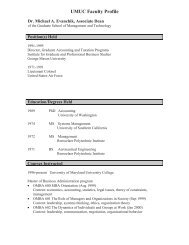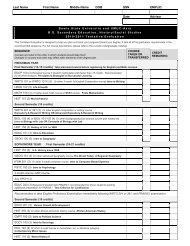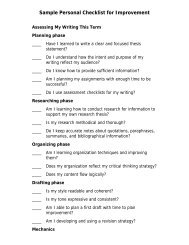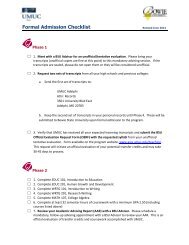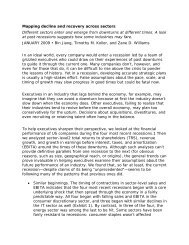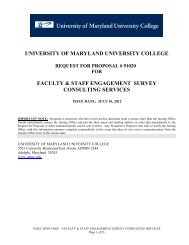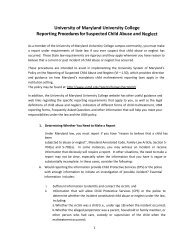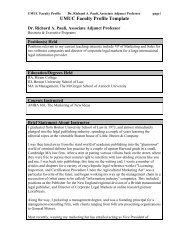1a. IntroSUS 2003 - University of Maryland University College
1a. IntroSUS 2003 - University of Maryland University College
1a. IntroSUS 2003 - University of Maryland University College
- No tags were found...
Create successful ePaper yourself
Turn your PDF publications into a flip-book with our unique Google optimized e-Paper software.
Requirements for the MinorThe minor in business supply chain management requires the completion<strong>of</strong> 15 semester hours <strong>of</strong> coursework in business supply chainmanagement, drawn from various disciplines as appropriate; at least9 semester hours must be earned in courses numbered 300 andabove. Specific course requirements are listed below. If a specificcourse required for the minor is taken instead to satisfy requirementsfor a major, another course in the same discipline should be substitutedto fulfill the required minimum number <strong>of</strong> semester hours forthe minor. Any course used to replace an upper-level course shouldalso be classified as upper level.For a listing <strong>of</strong> all the requirements for the bachelor’s degree, studentsshould refer to pp. 22–23.Business Supply Chain Management Coursework (15 s.h.)Introductory Courses (6 s.h.)Students must take two <strong>of</strong> the following courses:BMGT 304 Managing E-Commerce in Organizations (3)BMGT 309 Operations Research for Management Decisions (3)BMGT 317 Problem Solving (3)BMGT 385 Production and Operations Management (3)Supplemental Minor Courses (9 s.h.)Students must take at least three additional courses from those introductorycourses not already taken and the following courses:BMGT 230 Business Statistics (3)BMGT 301 Computer Systems for Business (3)BMGT 305 Knowledge Management (3)BMGT 370 Introduction to Transportation Management (3)BMGT 372 Introduction to Logistics Management (3)BMGT 375 Procurement Management (3)BMGT 383 Planning and Control <strong>of</strong> Services (3)BMGT 384 Managing for Quality (3)BMGT 388B Virtual Management (3)BMGT 412 Program Analysis and Evaluation (3)BMGT 487 Program Management I (3)BMGT 488 Program Management II (3)BMGT 491 Exploring the Future (3)MRKT 318 Exploring Internet Marketing (1)MRKT 457 Web Marketing (3)Communication StudiesStudents may seek either an academic major or minor in communicationstudies.Major in Communication StudiesA major in communication studies provides for the growth <strong>of</strong> adultlearners as expert communicators who can meet the challenges posedby the global workplace and the global presentation <strong>of</strong> public information.The major’s cross-disciplinary approach produces graduateswho have the appropriate balance <strong>of</strong> theoretical background andsophisticated, practical communication skills needed in today’s workplaceand public information environments.ObjectivesThe student who graduates with a major in communication studieswill be able to•Discuss the history <strong>of</strong> communication theory and how its principlesapply to particular types <strong>of</strong> communication, includingmass communication.•Apply effective communication strategies within various types<strong>of</strong> communication.•Gather information from a variety <strong>of</strong> sources and criticallyidentify, examine, and present issues associated with informationcommunicated to diverse audiences.•Apply the techniques <strong>of</strong> independent research, including technologythat fosters information literacy.•Recognize the legal and ethical implications <strong>of</strong> communicationand produce communications that are legally and ethicallyresponsible.•Explain how computer technology is used to developand manage information and employ appropriate computerresources to increase the efficiency and effectiveness <strong>of</strong>communication.•Write and edit effectively and demonstrate a clear understanding<strong>of</strong> the respective processes, tools, and techniques that applyto various types <strong>of</strong> communication.• Assess a particular communication environment and evaluatethe communication skills needed for that environment.•Develop communication products and processes appropriate toa given audience.•Demonstrate an understanding <strong>of</strong> the elements <strong>of</strong> typography,layout, and design and apply them effectively to various kinds<strong>of</strong> communications.44





